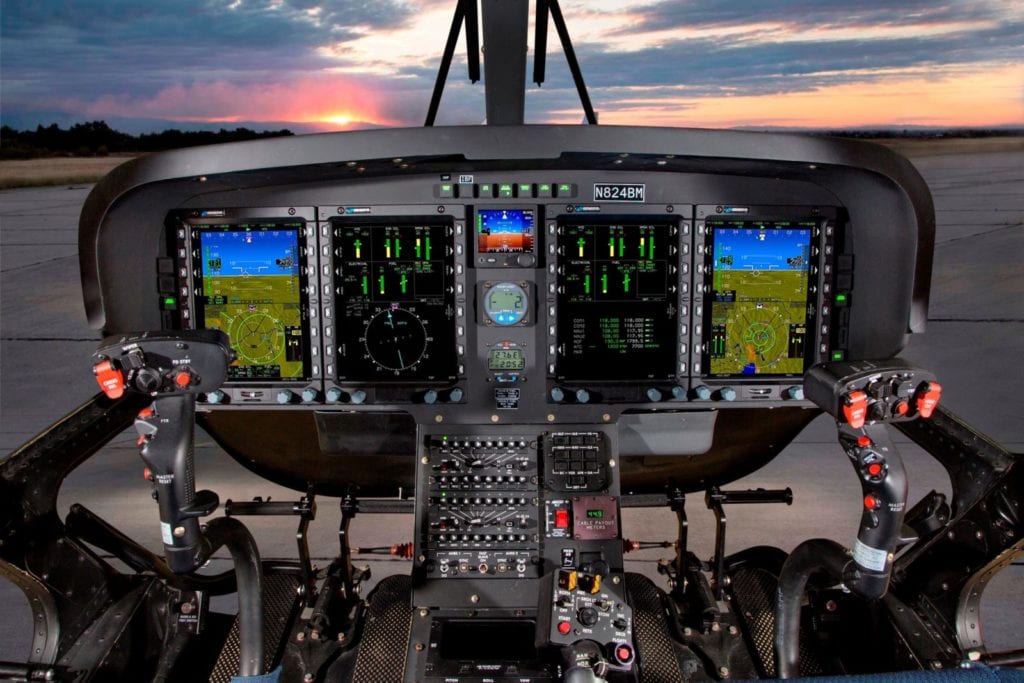
The Leonardo TH-119 training helicopter for the U.S. Navy includes an avionics suite by Genesys Aerosystems. Photo: Leonardo
The four-screen, all glass, digital cockpit of the Leonardo TH-119 will ease the training burden on the U.S. Navy for a new generation of helicopter pilots, according to Leonardo.
The “dual-display Genesys Aerosystems’ advanced glass cockpit allows instruction from either pilot seat with full IFR [Instrument Flight Rules] capabilities including flight director and 3-axis full autopilot,” Leonardo said. “Its unique 180-degree adjustable observer seat offers student pilots full view of the cockpit providing a better learning environment even while riding as a passenger.”
This week, the single-engine TH-119, derived from Leonardo’s AW109 Trekker, beat out the Airbus twin-engine H135 and the Bell 407GXi single-engine helicopter for a $176 million contract to produce and deliver the new TH-73A Advanced Helicopter Training System (AHTS) to replace the Navy’s fleet of TH-57 trainers based at Naval Air Station (NAS) Whiting Field, Fla.
TH-57 models have served as the Navy’s training helicopters since 1968.
The AHTS’ avionics suite by Genesys Aerosystems, based in Mineral Wells, Texas, includes four IDU-680 displays in a dual-sided Primary Flight Display/Multi-Function Display (PFD/MFD) format with dual redundant Air Data, Attitude and Heading Reference Systems (ADAHRS), dual Global Positioning System/Flight Management System (GPS/FMS), dual Data Acquisition Unit (DAU), and other supporting sensors, according to Genesys Aerosystems.
The Navy was to make a down-select decision on the “best value” AHTS contract in November among the three helicopters. The TH-119 and 407GXi helicopters received their IFR certifications last July and August, respectively.
The Navy required IFR certification for the AHTS competition by the end of last August.
The FAA’s IFR certification of the TH-119 in July marked the first time in decades that the agency had certified a single-engine rotorcraft.
“The Level A, IFR-certified IDU-680 is a large EFIS (Electronic Flight Instrument System) display that offers high-resolution LCD glass depicting 3D Synthetic Vision, Highway-In-The Sky (HITS), Enhanced HTAWS [Helicopter Terrain Awareness and Warning System], Integrated FMS, Hover Vector, and many more features,” according to Genesys Aerosystems.
The Navy is to buy 130 of the helicopter trainers in five years and divest its TH-57 fleet by 2023. Secondary contracts are also expected for ground based simulators and performance-based logistics to support the AHTS.
The $176 million contract to Leonardo covers production and delivery of 32 aircraft, spares, various support and ancillary equipment, and training. The work will be split among Philadelphia (87 percent); Mineral Wells, Texas (5 percent); and various sites outside the continental U.S., the Navy said. It is expected to be finished by October 2021.
Last September, Leonardo said it would build a 100,000 square foot customer support center for the TH-119 next to NAS Whiting Field, if the company won the Navy training helicopter competition.